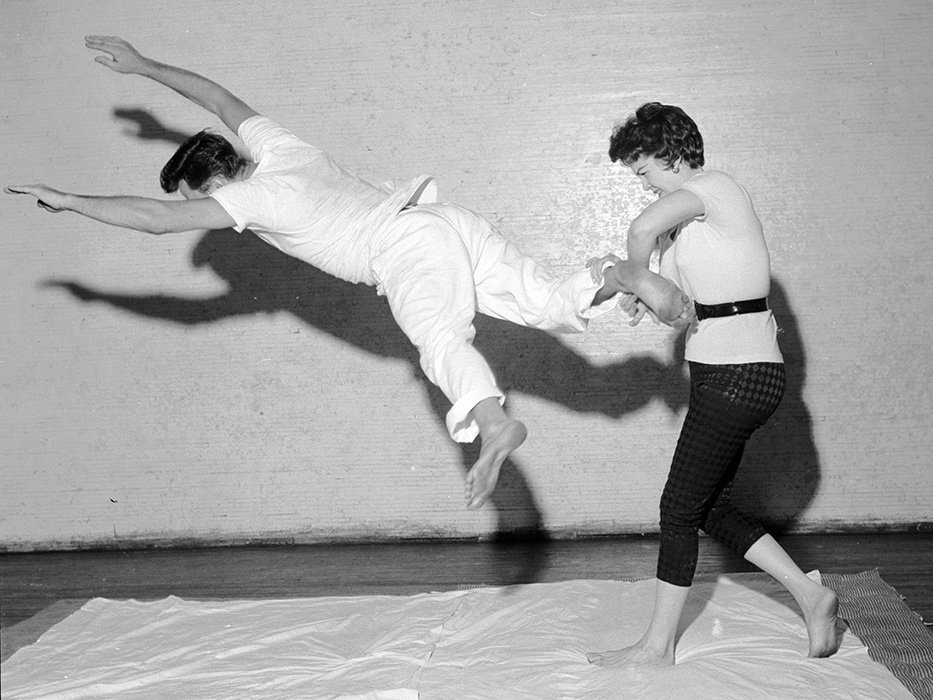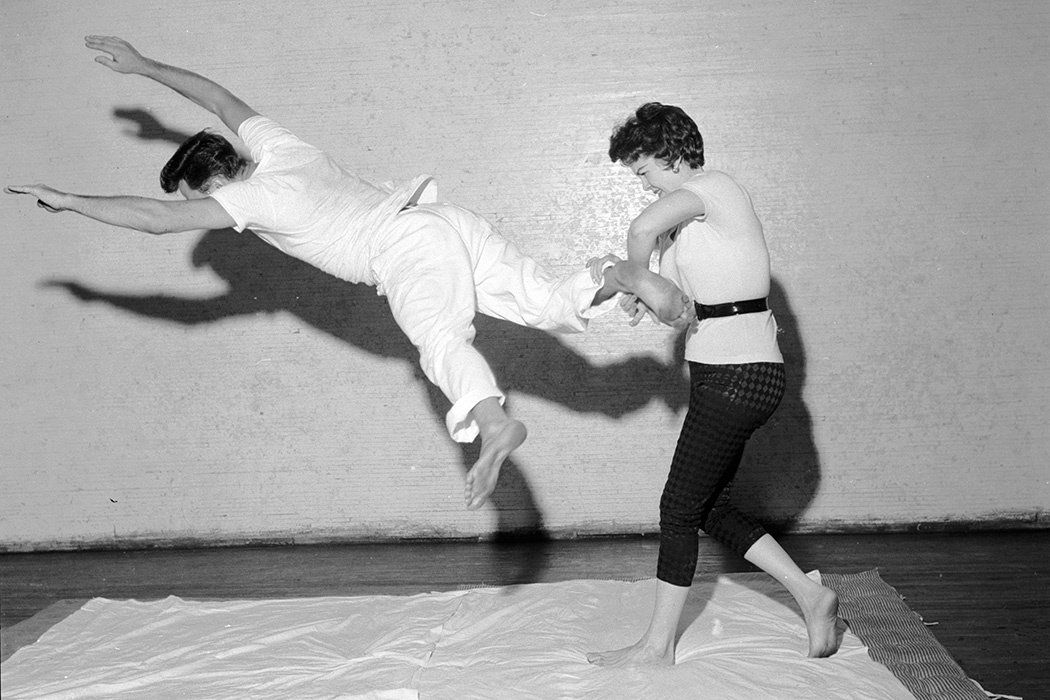A Tribute to Women Warriors (AKA Warriors)
“The best protection any woman can have is … courage.”
—Elizabeth Cady Stanton
Empowerment Self-Defense has been around for over 40 years as a holistic system of self-defense, originally designed by women for women to practice violence prevention strategies in a safe space. However, earlier forms of organized women’s self-defense were popping up in the United States and Britain over 100 years ago. We share this history with gratitude for the historians who have brought us these stories. (Please see the Resources list at the bottom of this blog for more information.)
“Woman must not depend upon the protection of man, but must be taught to protect herself.”
—Susan B. Anthony
Women’s Rights & Women’s Self Defense
The history of women’s self-defense tracks closely to the women’s rights movements of the 19th, 20th, and 21st centuries. Women began organizing for the right to vote in the first half of the 19th century, led by heroes like Elizabeth Cady Stanton, Susan B. Anthony, Sojourner Truth, and so many others. As women found their voices and inner strength over the decades, they also discovered their physical strength. Several decades into the women’s suffrage movement, American and British women turned to self-defense in the form of boxing, wrestling, and martial arts, especially jiujitsu and judo.
There was a need. After the Seneca Falls Convention and countless lectures and marches, women began to enter the parts of public society from which they had previously been banned, parts long considered the domain of men. Sometimes, the pushback was violent. Police officers, jailers, men on the street, husbands, fathers, and brothers pushed back collectively and separately—in jails, public spaces, and private homes.
So, women learned how to protect themselves.
Martial Arts & Public Spaces
“Reformers and suffragists led the way….arming women with the physical skills they need to defend themselves from attacks—or at least fear of attack—on the streets as they negotiated their place in the public space of the city,” write Rouse & Slutsky, authors of Empowering the Physical and Political Self. As female boxing and martial arts gained popularity, so did women’s self-defense.
In 1905, Edith Garrud trained suffragettes to evade the police and to defend themselves, applying her knowledge of jujitsu as well as personal experience, according to Irene Dellinger, author of Suffragists, Actresses and Activists Do It: 100 Years of Self-Defence. Unlike many others at the time, Garrud also taught and promoted self-defense as a means of preventing domestic violence assaults. Meanwhile, in New Zealand, actor Florence Le Mar published self-defense tactics and held self-defense workshops for the women in her vaudeville act.
Around the same time in Oakland California, a telephone operator named Nellie Griffin was approached by a man on her walk home from work. He made several advances and grabbed her arm. Griffin replied by punching him in the face. She later told reporters, “I have waited too long for some bystander to take up the fight for me, but as no one ever volunteered, I was compelled to assert my rights.”
The history of women’s self-defense is full of stories like these, of women deciding to stand up for their safety, rather than waiting for someone else to step in.
Women of this era also understood the impact they could make just by being seen. For example, Washington heiress Martha Blow Wadsworth put her privilege and access to good use, organizing a jiujitsu class for women in a very visible place, the White House lawn.
Powerful Women Have Always Been Out There
It’s not that history had never seen powerful women before. On the contrary, history is brimming with women who used their intellect, wits, beauty, and brawn to wield power and/or live outside the narrow confines of a woman’s world. Take the surprising number of female warriors.
Amanirenas, queen of the Kingdom of Kush (now Sudan) from 40 B.C. to 10 B.C. is famous for leading the Kushite army against the Romans in a five-year war from 27 B.C. to 22 B.C. It was reported that she lost an eye in battle. Queen Amanirenas and her forces attacked Roman Egypt gaining control of Syene (present-day Aswan) and Philae.
Fu Hao of ancient China was a military general in command of 13,000 soldiers around 1200 BCE. Tomyris, a warrior of Central Asia in 530 BCE, won a war against a Persian king. Queen Artemisia commanded five ships for the Persian King Xerxes when he invaded Greece in 480 BCE. Cynane, the half-sister of Alexander the Great, was trained to fight and defend herself by her mother, the Illyrian Princess Audata, in the 4th century BCE. The Celtic Queen Boudicca made a valiant effort to rid Britain of Roman rule in 60 CE, winning battles against the Roman legions. Triệu Thị Trinh was a Vietnamese warrior who took her homeland back from China in the 3rd century CE. Abyssinian Queen Gudit took her throne and ruled by force 700 years later. Tomoe Gozen of Japan, wearing armor and wielding a large bow and sword, fought fiercely in the Genpei War of the 12th century. In the 19th century, Yaa Asantewaa was queen of Ejisu in the Ashanti Empire (now Ghana). She was the only woman appointed leader of the Asante fighting forces. And in 18th and 19th century West Africa, thousands of women fought in an elite fighting force that commanded fear and respect among the people—the Dahomey Amazons’ ferocity in battle was legend.
A Self-Defense Revolution
The second women’s movement of the late 1960s and early 1970s catapulted women to independence, at least in the West. It also brought a resurgence in women’s self-defense, precipitating the National Women’s Martial Arts Federation. In addition, women formed their own self-defense groups, not wanting to rely on men to teach them. Considering that attackers are likely to be known to their intended victims, trailblazers developed women’s self-defense classes to prioritize safe spaces and more comprehensive theory and education.
Just like today’s ESD professionals, they believed it was critical to understand that violence occurs along a spectrum and that no woman should have to restrict herself in order to be safe. As the 1980s brought us IMPACT and the 21st century brought us the #MeToo movement, women’s self-defense experienced more growth within existing organizations and with new ones, like ESD Global, focused on training new instructors. It also became more inclusive, resoundingly rejected victim-blaming, and emphasized the empowerment element through a new name, empowerment self-defense (ESD).
“Even today, some self-defense instructors tell women they never should be alone on the street in an effort to promote safety. But that’s also telling women that their place isn’t on the street—their place isn’t in the public space…. And that’s not okay, because the truth is we should have the right to walk safely down the street. It was illuminating to me how in some ways self-defense instructors themselves perpetuate the idea that women don’t have the same rights as men.”
—Wendy L. Rouse.
We have seen what can happen when even one person with passion and purpose can make a difference. As a relative newcomer to the ESD field, we at the Association of ESD Professionals hope to help carry on the movement our foremothers began, always protecting and promoting the interests of women and girls even as we welcome people who are not women into the fold.
Through dedication, fortitude, sacrifice, and grit, we can prevent further violence. We know that change is possible. We invite you to continue the conversation and explore every possible avenue for collaboration to continue to grow together.
Author: Tasha Ina Church
Editor: Toby Israel
Photo: Getty Images
Do you want to know more about the Empowerment Self-Defense movement or the Association of ESD Professionals? Reach out at: Hello@ESDProfessionals.org
Sources
Tristan Hughes, “10 Great Warrior Women of the Ancient World,” history.com (September 14, 2021) https://www.historyhit.com/10-great-female-warriors-of-the-ancient-world/
Julia Halprin Jackson, “Her Own Hero: The History of Women’s Self-Defense,” San Jose State University’s Washington Square
Lindsey E. Jones, “Black Girls, Domestic Violence, and the Limits of Self-Defense,” Black Perspectives (September 13, 2016) https://www.aaihs.org/black-girls-domestic-violence-and-the-limits-of-self-defense/.
Wendy L. Rouse, The Origins of the Women’s Self-Defense Movement, NYU Press (August 8, 2017) discussing her book, Her Own Hero: The Origins of the Women’s Self-Defense Movement (NYU Press, 2017).
Wendy Rouse and Beth Slutsky, “Empowering the Physical and Political Self: Women and the Practice of Self-Defense, 1890-1920,” The Journal of the Gilded Age and Progressive Era, Vol. 13, No. 4, pp. 470-499, Society for Historians of the Gilded Age & Progressive Era (October 2014).
Patricia Searles & Ronald J. Berger, “Women in Society, The Feminist Self-Defense Movement: A Case Study” (3/1/1987) (this article can be read online if you register with JSTOR for 100 free views).
Mindy Weisberger, Beyond Wonder Woman: 12 Mighty Female Warriors, Live Science (June 2, 2017) https://www.livescience.com/59330-beyond-wonder-women-real-female-warriors.html
Matthew Wills, “How American Women First Learned Self-Defense,” JSTOR Daily, citing and quoting Wendy Rouse and Beth Slutsky’s “Empowering the Physical and Political Self: Women and the Practice of Self-Defense, 1890-1920” (3/29/2021).
Irene Zellinger, “Suffragists, actresses and activists do it: 100 years of self-defence,” Open Democracy (December 9, 2016) https://www.opendemocracy.net/en/5050/suffragists-actresses-and-activists-do-it-100-years-of-self-defence/.
Ricky Riley, “5 Real Life African Women Warriors Throughout History As Badass As General Okokye And The Dora Milaje,” Blavity News (February 22, 2018) https://blavity.com/5-real-life-african-women-warriors-throughout-history-as-badass-as-the-dora-milaje?category1=black-history&category2=culture&item=4

